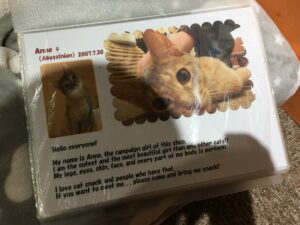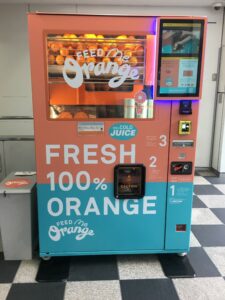Knowing my penchant for retro gaming and vintage computing, for a few years now several friends of mine have recommended I visit Tokyo, Japan, specifically the Akihabara ward famous for its shops full of esoteric electronics. I had booked such a trip for April of 2020, but… nature had other plans. Now that individual tourism has opened up a bit in Japan, I finally booked my visit for real, having never been before, and spent a week there. My planned purpose of the trip was to see if a market for second-hand Pippin gear exists and if so, if I could bring home any Pippin-related goodies, particularly hardware. I also wanted to meet with a friend in Tokyo whom I hadn’t seen since he moved there prior to the start of the COVID-19 pandemic. All in all I quite enjoyed my trip, and so this post will be decidedly less technical than usual as I document what I did during that week.
Day 0 / Wednesday
I took a red-eye flight out of Oakland International Airport, arriving at Honolulu International Airport the next morning. I generally prefer red-eye flights so that I can make the most of my time on them—if I’m tired enough I can fall asleep anywhere, and then I don’t remember whether the flight is good or bad when I wake up and land. When I landed at HNL though, I wanted breakfast, but most places I found are geared toward cocktails and so naturally aren’t open in the morning. I wound up grabbing a quick bite at Burger King as a sort of “last chance” at U.S. food before continuing west, somewhat reminiscent of how my dad and I grab a “last chance” Runza in Sidney, NE before leaving the state heading west on I-80.
The second leg of my Tokyo-bound flights took me from HNL into HND, or Haneda Airport / Tokyo International Airport. For this flight I had an aisle seat way in the back of the plane (an Airbus A330), but fortunately nobody was in the window seat by the time we took off, so I got the whole row to myself for the next 9+ hours. Hooray! I’ve been told that the best way to overcome jet lag on long international flights is to force yourself to stay awake until you reach what would be considered “bed time” at your destination. Accordingly, to pass the time I watched three movies on this flight: Top Gun Maverick (liked it; good), Bullet Train (liked it; haha), and Moonshot (did not like).
My first impression of HND upon touchdown was that it is a large airport. I hadn’t been on an international trip since 2012, so perhaps I had simply forgotten how big international terminals are. But nevertheless, before doing anything else upon arrival I had to pass through customs. The long walk from my arrival gate to the customs area was peppered with advertisements for “Visit Japan Web.” This is a site whose purpose is to expedite the customs process by providing customs forms online, then upon completion of those forms produces a pair of QR codes which you then show to customs officials. The customs officials at HND speak very little English, but fortunately I didn’t have to say very much because I had already read of Visit Japan Web prior to my flight(s) and so had filled out the necessary forms and received the requisite QR codes. It was slightly confusing to be directed first to a pod full of laptops (“Oh, maybe this is where I scan my QR codes” I thought) but as it turned out those laptops exist for folks who didn’t come prepared and would have to go through Visit Japan Web there instead. Once that was made apparent to the customs official, I was instead directed to the main queue for immigration.
Customs is a two-part process: immigration and declaration. Each part has its own QR code via Visit Japan Web. The immigration line was long, but at least moved along steadily. It took maybe ten minutes to get through immigration, wherein my fingerprints were scanned and a photo of my face was taken. Claiming my luggage took another ten minutes, then declaration was done at a QR code scanning kiosk. Finally, with all customs procedures complete, I simply walked out of the customs area via a guarded exit gate. Welcome to Japan!
Priority number one after customs (for me) was retrieving my pocket WiFi device. My carrier doesn’t provide cellular data service in Japan, so my options were either to register with a local carrier (necessitating a new phone number and a new SIM card) or rent what’s called a “pocket WiFi.” Pocket WiFi devices basically amount to a cellular data hotspot; they are pocket-sized battery-powered devices that piggyback off of 5G/LTE cell services in Japan to provide a WiFi hotspot that my personal phone can connect to just like any other WiFi network. In this way, I could carry a tiny WiFi network with me in my pocket (hey!) and log in to the Internet telephony and chat apps I already know and use on a regular basis. This seemed far more convenient to me, so I made sure to preorder one of these over a week ahead of my trip to be picked up at the respective point when I landed. When I got to the pocket WiFi counter though, the problems started. The gal behind the counter fortunately spoke English pretty well, but informed me that they did not have a device for me. I was confused; not only had I preordered one, but I had the confirmation email in my hands on my phone, which I showed to her to try to explain my perspective. If I had cancelled, wouldn’t I have received a cancellation email as I had done when my order was first confirmed? No such cancellation email existed. After a bit of (polite) back and forth, to their credit the pocket WiFi folks acknowledged that because a refund for my “cancelled” order had not gone through, that they could furnish me with a device to be delivered directly to my hotel the next evening. This was annoying but, given my options, I found it the most acceptable, so we went ahead with that plan and I looked forward to moving on to priority number two.
In retrospect given the tight timeline I don’t think I could have reasonably expected to retrieve both my pocket WiFi and my JR Pass that evening, but I should have been able to get one or the other. In my case, I got neither that evening. The back and forth at the pocket WiFi counter took me well past 8pm, by which time the JR ticket office had closed to new customers. The JR Pass is offered only to tourists, and it is a fixed-rate pass that allows unlimited travel on the train lines operated by Japan Rail. The pass itself costs a couple hundred U.S. dollars, but given that I was expecting to ride the shinkansen (bullet train) at least twice later that week, this made the pass well worth it. As with my pocket WiFi, I had ordered a JR Pass weeks earlier, after which I received a voucher in the mail to be exchanged at a JR ticket office for my real pass, valid for the week-long duration of my trip. But with the office closed, and without WiFi, I was suddenly faced with the unexpected task of not only navigating the JR ticketing system on my own, but without any cash, and without any way to translate the stations on the map into the romanized names I knew. In particular, I needed to know how I was going to get from Haneda Airport to Akihabara and Ryogoku, where I was scheduled to stay for the week.
Enter a very sweet helpful bilingual businesswoman who saw I looked lost and alone, so not only accompanied me to an ATM where I could get cash (luckily my debit card worked!) but then walked me through buying a transfer ticket to Akihabara via the monorail system, the latter of which I had no idea about previously. I didn’t get her name but nonetheless I thanked her profusely; despite not having a lot of faith in Japanese transportation services at this point, I had a reason to believe in Japanese humanity thanks to her. 🙂
The trains in Tokyo follow a schedule similar to BART in the Bay Area: after midnight, the lines start shutting down until the next morning. It’s a long walk from Akihabara to Ryogoku Station, but I was reluctant to try the train again until I could be sure I could get my JR Pass, so I walked from Akihabara Station to my hotel, dragging along my big leather suitcase and my garment bag and my tenor saxophone and my twelve-pound bowling ball and my lucky lucky autographed glow-in-the-dark snorkel luggage. My first impression of Tokyo streets was that they are safe, and quiet at night; my rolling luggage made the most noise, and my presence after 11pm didn’t seem to disturb or otherwise arouse suspicion from others on the street, nor did I notice an abundance of caution from the same amongst themselves. I wound up getting to bed by midnight, about two hours later than I expected to.

Day 1 / Thursday: Akihabara, Part One
I woke up around 7:30am and got used to the shower. “Small” isn’t an accurate enough word to describe my hotel room at the APA Ryogoku Eki Tower; although I concur that the total square feet is less than in a typical Western hotel room, the space is used very efficiently. I would describe my room as “compact,” and this definitely extended to the bathroom and shower.
The water spigot serves both the sink and the shower, and only one or the other may be used at a time. The interface took a moment to figure out, but it’s kind of clever: the temperature is regulated by a knob on the left side, with a red “safety catch” intended to keep the water at or below 40 degrees Celsius unless I really wanted otherwise. The knob on the opposite end of the temperature control governed the shower pressure: all the way one way maxed out the pressure, and all the way the other way turned the shower off. I was very delighted that the shower head itself was optionally handheld; I have a similar setup at home and it certainly helps being able to thoroughly wash in my decidedly more cramped quarters here.
One thing about this bathroom that stuck out and impressed me was how the mirror behind the sink stayed clear while the rest of the mirror retained condensation from the steam of the shower. I’m not sure how this was done—maybe a heating plate behind that section of the mirror?—but it was another small detail that I appreciated. American hotels should take note!
Another tiny detail that seems like such a small thing but with a potential to make a huge difference was the drain guard in the sink. There are two levels to the “grate” of the guard, each offset by one another, so that for example if you lose a piece of jewelry down the drain, the drain guard has a better chance of catching it. Again, I was impressed by this too and would love to see this become standard issue in the States.
The last time I went on an international trip was in 2012 to Thailand, and the one thing I regret not doing when I was there was sample the McDonald’s in Bangkok. Each country’s McD’s has a menu tailored to their respective cuisine, and I knew Japan would be no exception. Luckily there was a McD’s right across from Ryogoku Station so for the first few days of my time in Tokyo I ordered hotcakes and orange juice, all in what little spoken Japanese I know. Knowing how and when to say “hai” (yes) and “arigatou gozaimasu” (thank you) got me pretty far. 🙂 The breakfast menu is more or less the same as in the U.S., except that the McD’s in Tokyo doesn’t offer breakfast biscuits. Instead, you can get bacon, egg, and cheese “McSandwiches,” which are just bacon, egg, and cheese on seedless burger buns. I didn’t try them.
Even though my pocket WiFi would not arrive until later that evening, I wasn’t about to let that stop me from making the most of my day. My hotel room came with its own WiFi network, so I relied on that in the morning to plan my itinerary in advance. The first order of the day was to find a JR ticket office and get my JR Pass. I found via Googling that there’s a JR ticket office at Tokyo Station, which was the next biggest station south of Akihabara. I found and downloaded an English version of the train map seen in the JR stations, and used that to figure out what kind of ticket to get to Tokyo Station. Once I got to Tokyo Station, finding the JR ticket office was easy and I only had to wait about 45 minutes in line before I finally was able to exchange my voucher for my actual JR Pass. Since it was Thursday by this point, they set up the pass so that it would expire by next Wednesday, which was fine by me as I expected to be back home by then anyway. The gal exchanging my voucher also assured me that I could keep the physical pass as a souvenir at the conclusion of my trip; they didn’t need the expired pass back when I was done with it. I was free to ride the JR trains anywhere within Tokyo, so with my JR Pass in hand and feeling a lot more comfortable, I headed back up to Akihabara Station and began touring the area in earnest. 🙂
My first shopping stop in Akihabara was a tall building with a sign advertising “Book-Off,” which was a brand in a family of stores I knew specialized in second-hand goods. I stopped into this building to quickly find it wasn’t much of a second-hand store at all, but instead a store called Onoden. Still, there were some neat items for sale here, notably some high-end home audio gear.
As I moved on from shop to shop, searching specifically for Pippin and Mac-related items but keeping my eyes and ears open to anything else that might capture my attention, I made a few observations and formed some corresponding impressions. First, very few of these stores would be legal in the United States from an accessibility standpoint. Someone who is not ambulatory would have a very hard time navigating many of the tight corridors and narrow stairwells/escalators, assuming options other than stairs are available at all. Second, the overall theme of Akihabara I would describe as surplus stores; many little individually-owned shops selling components and cast-off electronics like radios, laptops, audiovisual equipment, and other appliances. However, unlike the beloved now-closed Bay Area outlets like WeirdStuff Warehouse and Excess Solutions, when it came to computers I couldn’t find any vendors in Akihabara offering accessories for anything older than an iPhone 8. Accordingly, most of the focus is on phones and mobile devices.
Vending machines are everywhere. There is no shortage of drink options should you find yourself parched while on the street gawking at all the shiny toys available for sale. I bought a Dr. Pepper while on my way out of the “ICOM” store.

I popped into a place called “Yellow Submarine” which billed itself as a hobby store for collectors of TCG, tabletop gaming, and model kits. They had a floor in the building for some Mac stuff, too, going back to the late PowerBook era. I bought another drink from a vending machine here: “Aquarius” from Coca-Cola. Supposedly served to the Olympians during the 2020 games, this drink looked to me for all the world like water, but a sip of it tasted a bit… off. It was clearly flavored with… something… but I just wanted regular water. Maybe Aquarius has what plants crave? 😉
By this point it was time for me to track down the three Hard-Off locations I had pinned in my Google Maps. The Google Maps app on my phone keeps them locally cached, so I had no problem finding them by walking along to the map, nor did I ever feel like my personal security was in jeopardy doing so. 🙂 I had higher expectations for Hard-Off than what I experienced. The stores I went to were pretty small, albeit on several floors. They were average sized by Akihabara standards, but I suppose I was expecting something nearer to the scale of the Sofmap store I had visited earlier that day.
All Hard-Off locations seem to play the same in-store music, so it started to get ingrained into my head as I searched the “junk” floor looking for vintage Mac and Pippin gear, plus whatever else struck my fancy. There is no shortage of retro video game hardware, from controllers to systems, but good luck finding anything rare on a regular basis. I did find with some regularity a variety of LaserDisc players, DVD players, and videocassette machines, including one ED Beta machine at one location. But overall, the Hard-Off stores in Akihabara left me less than impressed. Perhaps I would have to explore locations outside an area frequented by tourists. 😉
Another store I had on my list of must-see places was Mandarake. There are a few locations in Tokyo, and the first one I visited was in Akihabara, spread over at least six floors. The sixth floor is where the games were, so naturally I made a beeline directly for that section. Here is where I found the most promise, at least so far: behind glass in the back corner of the floor were a couple of reasonably-priced Japanese Virtual Boy titles, complete in box. Elsewhere in the shop, I found a stock of games for the Bandai WonderSwan. This game me hope: if games for the Virtual Boy and WonderSwan—system that are commonly considered “failures”—were stocked in stores like this, maybe I might find something for the Pippin, another “failed” platform. In fact, this was not the only location where I could find WonderSwan-related products; this was the case in at least a couple of retro game shops in Akihabara.
I needed a bit of a break from all this shopping and searching, so I dropped into a few nearby arcades. The GiGO near the train station looked impressive from outside, but inside it was mostly crane machines. Likewise, the Taito arcade was a lot of crane machines, but they also had a few “candy cabinets” and Vewlix-style machines. HEY, or Hirose Entertainment Yard, had the most variety: the first floor is crane machines, but the second and higher floors have a mix of sit-down cabs and dedicated cabs. Pricing is pretty reasonable, too: typically only 100 yen per play, which is a little less than $1 USD. Even though I was wearing a mask, I was happy to find that the arcades didn’t have an overbearing smell of smoke as I expected they would. Smoking appears to be limited now to a designated smoking room within the arcade. Whether this was a change prompted by COVID-19 or independent of that, I’m very appreciative of it.
No trip to Akihabara is complete without a visit to the legendary Super Potato. This is a shop that I had heard of long before planning what was going to be my first voyage to Tokyo in 2020, but again like Hard-Off I expected it to be at least 3x the size it actually is. Its offerings inside left me similarly unimpressed. I think in the time since I had first heard of this place, they got wise to tourists seeking them out, and their prices since reflect that savvy. In any event, nothing for the Bandai Pippin could be found here. I was tempted by something, though: on the bottom shelf were four boxed PC-FX systems, which are somewhat hard to come by in America since they were only marketed in Japan. The PC-FX shares a little bit of DNA with the Virtual Boy, but at about $300 USD apiece without any software, I couldn’t justify it. Nor could I justify any of the boxed Virtual Boy games they had for sale, also behind glass as at Mandarake.

Next I explored BIC CAMERA which, despite its name, is more of a general department store ala Target, albeit a little more high-end. Phones, computers, gaming setups, groceries, toiletries, appliances, digital pianos, toys, games,… they had a little bit of everything. I was a little astonished to see for sale a handful of digital pianos from Roland, Yamaha, and Casio.

The top floor is the toy floor. About a quarter of this section is dedicated to LEGO. Many figurines and model kits were available too. I found both die-cast models and DIY kits of every DeLorean from the Back to the Future movies.

The grocery floor impressed me by its large selection of liquor, both local and imported. All were available at pretty reasonable prices; I didn’t see any bottles going for much more than $50 USD. There was a small selection of candy, too, but not only did I not want to buy a souvenir bottle of whisky this early in my trip, but I also wanted to go to a specialty store for Japanese KitKats, so I ultimately passed on this floor. If I do come back to Akihabara, though, I know where I can go to restock on anything I either run out of or forget.
By the way, Hard-Off doesn’t exclusively deal in electronics; they sell musical instruments too, though it’s mostly guitars and synth gear. A handful of wind instruments for sale can be found behind glass, which suggests to me that a lot of folks try guitar/synth before selling it back to the store when they realize it’s not for them. XD
For dinner, I got brave and decided to pop into a highly rated katsu curry place back near the train station. This place was operated by a vending machine, too! You put in your money, press the button labeled with the name of your desired dish, then out comes a ticket that you hand to the cook. It’s all printed in Japanese, of course, but next to the machine is a picture menu with English descriptions next to their Japanese descriptions. So I was able to easily order a deep fried pork katsu curry by matching up its button to its English equivalent on the picture menu. It was so good and well worth it. I was very happy I did that. 🙂
To cap off my evening, I backtracked to the Mister Donut next to the Sofmap store. Mister Donut used to have a presence here in the US up until the 90s, at which point many of them became Dunkin Donuts locations instead. Indeed, as of this writing I think the only Mister Donut store left in the United States is in southern Illinois. In the late 70s, my dad used to work at a Mister Donut location in Lincoln, Nebraska, so I had to stop here to at least give him a blast from his past. Mister Donut must have really found a market in east Asia, because they had at least one in Bangkok when I visited there, too. Japan even plays host to a Mister Donut Museum. But for the moment, I just wanted some donuts, so I ordered three cake donuts plus an “iced milk” shortly before their scheduled closing time of 7pm. When it comes to milk, they’ve got both kinds country and western “hot” and “iced” — you can’t get any more specific than that.
Day 2 / Friday: Akihabara, Part Two
This day was meant to finish up any Akihabara shopping that I didn’t get to on Day 1. This included Beep, Surigaya (next to Beep), and Trader. Beep and Surigaya both opened at 11am, so after breakfast at McD’s again, I trekked into Akihabara to wait outside Beep first before they opened.

Beep is a basement store. Many older Japanese computers like the NEC PC-9801 and MSX are offered here, but very little from Apple. I found nothing Pippin-related here. In fact the only Apple items I found in the store were a caddy-fed external AppleCD, an external Apple 5.25″ Drive, an ADB Global Village modem, and an Apple-branded tea mug, the latter of which was only on display on a shelf near the ceiling. Once again, I left emptyhanded.
Surigaya was similarly unimpressive; I didn’t buy anything here. The most interesting item I found was what looked to me like a Super Famicom modem from NTT Data. As I saw in Mandarake the previous day, there was a surprising amount of WonderSwan goodies here too. Trader is more of a media shop specializing in books, videos, software, and hobby kits, with almost no electronic hardware for sale. I was intrigued by a sign pointing me to “PC” games near the top floor; maybe I could find some hidden gems there? And indeed I did find a handful of PC games I was familiar with (like Caesar III, for instance), but though the games were for PC, it became immediately clear perusing the aisles that the games weren’t, ahem, PC—a bit of a cultural shift I had yet to get used to. 😉
With my visits to those three remaining stores on my list of bookmarked locations, I declared my shopping excursion into Akihabara complete. No visit to Japan is complete without spending some time in a cat café, either, so my next stop was Neko JaLaLa. This is a very unassuming place on the less-traveled outskirts of Akihabara, but the signs on their front door facing the street make it obvious that cats live here. 🙂 To gain entrance I purchased a drink of my choice (a fruity hot tea, very similar to the berry blend I make at home) and 60 minutes of play time with the kitties.

I immediately met Cookie, a very social cat who reminded me of my folks’ cat. He is much slimmer than my folks’ cat, but he is just as rambunctious.
On the opposite end of the spectrum was a very fluffy cat named Moja, short for “moja moja” which in Japanese means “fluffy.” 🙂 Moja looked very familiar to me so I took a liking to him right away. He was content with sitting high atop the cat houses looking down or at eye level with his human visitors. At one point he climbed aboard the cat “bridge” built to hug the ceiling above people’s heads. If you could get to him, he would let you pet him, but he made you work for it.
These cats are well cared for. One might even call them spoiled, for they have nothing to want for in their lives. 😀 Most of them were perfectly happy napping in their respective houses; there were close to a dozen cats in this café. A sure way to get the attention of a few of them was to buy them a treat, of which several varieties are offered here. I bought one pureed fish treat and shared it among three new feline friends. I suspect these cats have come to expect this on a daily basis and so are generally not interested in being social unless somebody has something to offer them. 😀
This is Anne, or rather this was Anne. :'( I noticed Anne lying down in the corner of the café under a blanket on a padded mat, away from the interests of other human visitors. Her eyes were open but she wasn’t as active or lively as the other cats, so I thought to pay her some attention. As soon as I did, it was explained to me that Anne was born in July of 2007 and was one of the most “senior” cats on staff at Neko JaLaLa. But she had developed a tumor behind her nose and was expected to “go to Heaven” (the staff’s words) either that day or the following day. The tumor had gotten so bad by the time I met her that it prevented her from closing her eyes, so every few minutes one of her humans would come out with some eye drops and a tiny cloth to clean her up and make her feel comfortable.

I spent the most time with Anne, softly stroking her thin coat on the back of her head and neck. Near to when my time was up, Anne was determined to get to her feet, which must have been quite the surprise because it got the attention of the entire human staff of the café. It was as though she suddenly felt energized enough to say “hi” for one of her last times, so I returned the favor by giving her pets and telling her she was a very good kitty. On my way out, the staff thanked me for spending so much time with Anne. It still chokes me up to think about it, but I was happy that I got to meet her even if just for that brief hour. She did indeed pass away later that day, and was cremated over the weekend. She’s a jellicle cat now. RIP Anne 2007-2023 <3

Having had enough of Akihabara, I boarded the train west to Nakano Broadway, a multi-story indoor shopping mall a few stops away from Shinjuku. I came here to find the Mandarake Special 4 location and the Lashinbang Audio Video Shop, but what I thought was an escalator to the second floor actually took me to the third floor, so I thought for a few minutes that maybe Google Maps was outdated and the shops no longer existed. Nope—a nearby stairwell was helpfully labeled with the floor number, and sure enough when I descended to the proper second floor, I found both.

Though the Mandarake store at Nakano, like its Akihabara counterpart, had an impressive collection of collectibles, once again I left emptyhanded. What I was looking for continued to be far too specific. This location however was spread out across multiple units within the mall, giving me the impression that it covered more square footage than the Akihabara location.
By this time it was nearing 5pm and I was ready to meet up with my friend Jonas for one of two must-do meals I wanted to cross off my “bucket list” before returning home to the U.S. That night, that meant finding a table at a local fugu restaurant. Fugu, or the tiger pufferfish, is known for being lethally poisonous to humans, so chefs in Japan must go through rigorous training and certification in order to legally prepare and serve it. If not properly removed, the toxin causes muscle paralysis while fully conscious, leading to a slow death by asphyxiation… not a great way to go. But nevertheless, Jonas booked us a table at Tora-fugu Tei Shinjuku, which came highly rated online. I liked those odds, so despite the warnings (and hearing that the flavor was not actually anything to write home about), I was excited to try fugu for myself.
But first, upon arriving at Shinjuku Station, Jonas and I wanted to square away our shinkansen tickets for the next morning (Saturday), when we planned to spend several hours at Universal Studios Japan in Osaka. Reserved seats are not required on the shinkansen (bullet train), but they do help alleviate the stress of figuring out where to sit, especially in my case being a tourist and wanting to take in some of the picturesque scenery on the way down. We couldn’t find two seats together on the Mount Fuji side of our southbound train, but we did find two seats together on the ocean side of our train. So I booked a window seat for myself first, with Jonas following up shortly thereafter. Much to my annoyance though, in the span of less than a minute between getting my reserved seat and Jonas booking his seat, some stranger booked the seat right next to mine! The travel center where we might be able to change seats wouldn’t open until 8:30am the next morning, by which time we hoped to be well on our way, so all we could do was throw our hands in the air and instead expect that there’d be plenty of opportunities to chat and catch up while we stood in line for various things at Universal. At least we’d be on the same train car (or so we thought).
Our fugu dinner was a preset series of courses, starting with fugu sashimi which was my first taste of fugu. What I had heard was absolutely correct: it tastes like a very bland whitefish, almost like nothing. The second / main course was fugu served hot pot style, with vegetables and tofu, to make fugu chiri, or stew. The tofu pretty much disintegrated upon contact with the water/broth, and by this point I was much more excited about the enoki mushrooms than the fugu, which I could barely taste anyway.
The third course was the only part of the meal I didn’t care for. After we were satisfied with the stew, our server took the leftover broth, removed the bones/cartilage from what was left of the fugu, then added rice to soak up the broth. This turned the broth into a porridge of sorts which was beginning to look appetizing… until they turned off the hot pot and stirred in two raw eggs. D: My body has a very strong aversion to eggs—it doesn’t feel right to me calling it an “allergy” because to me an allergy connotes hospitalization or emergency treatment. It’s more of an “intolerance” in that I don’t have to get medical attention, but… eggs don’t stay down if I eat them and they are even the slightest bit undercooked. Fortunately for me, I haven’t had a problem with pastries and other baked goods, I suspect because they’re baked at such a high temperature for so long that whatever my body finds offensive is denatured or otherwise neutralized. Whew—I do love me some baked treats, which just so happened to be part of what was served as our final dessert course: a “monaka,” or an ice cream sandwich with red bean filling. All the while I enjoyed very delicious hot tea. This made up for my having to miss out on the third course, but the server was understanding and I learned a new Japanese phrase: “tamago nashi.” 😉
Of course in the midst of all this activity I forgot to take any pictures of any part of this meal or restaurant, but on our way out I did remember to snap a photo of the tank of pufferfish adjoining the entrance facing the street. All in all, I enjoyed my dinner here, but now having done it once, I can’t say that having fugu will be near the top of my dinner choices in the future. It wasn’t bad, it just was more about the novelty for me. As a bonus, I didn’t die. 🙂
To close out the evening, but being careful not to stay out too late, Jonas and I found a popular karaoke place at the “Pasela Resorts” in Shinjuku, near the train station. Given its name and that I found another one near Akihabara, I thought it was a chain of hotels, but inside we were presented with the options of a regular room or “premium” karaoke. Not needing anything fancy, we reserved ourselves a regular karaoke box for one hour and split a pitcher of liquid courage beer. The selection of Japanese tracks is of course excellent, but the selection of English songs is impressively large as well. The backing tracks, which in the U.S. I’m used to being pale imitations of the real thing, are pretty accurate here. My only complaint with this place is the tablet-based interface used to select songs: it’s really designed for searching, and not so much for browsing. Despite that, we still had a good time and I can truthfully say I enjoyed real Japanese-style karaoke while in Tokyo. 🙂
Day 3 / Saturday: Universal Studios and Osaka
Saturday morning turned out to be quite the adventure. After McD’s breakfast again, I met Jonas in Ueno around 8am expecting to board the shinkansen together, but right away we realized that something went errant in the course of booking our tickets the previous evening. While we were both booked for the same train, my ticket departed from Shinagawa Station, and Jonas’s ticket departed from Shin-Yokohama. In addition, Jonas found some kind of issue with his ticket and had to buy a new one for a scheduled 8:30ish departure on a different train altogether. What to do? Jonas came up with a brilliant plan whereby we each would board our respective trains from our respective departure points, and reunite later that day hundreds of miles away. 😀 So I rode past Tokyo Station to Shinagawa where I then discovered to my dismay that my reserved ticket was for April 2, not the 1st. This wasn’t a dealbreaker since my JR Pass let me get a non-reserved seat at no cost, and I planned on taking the shinkansen down to Kyoto on Sunday anyway, so my existing reserved seat would not go to waste. But in my rush to solve this new dilemma, I wasn’t paying attention to which train I was supposed to board. Instead of the Hikari line with fewer stops, I hastily jumped onto the Kodama line scheduled several minutes earlier, which only went as far as Nagoya, stopping at every station in between.

Ultimately our meetup in Shin-Osaka was delayed by about an hour to 12:30pm, but I was still amazed by how the plan became “let’s meet in another part of the country, good luck!” and it worked.
Getting from Shin-Osaka to Universal Studios involved taking a local train to Universal City, which was just outside the park, so that was quite convenient. We only had a few hours allocated to Universal on this day, and though I was excited to try at least one coaster, a couple of things worked against me there:
- Jonas doesn’t do roller coasters.
- The singles line for Hollywood Dream / Backdrop was 70 minutes, and climbed as the afternoon wore on.
I wasn’t about to blow my afternoon waiting in line for a single ride, especially given that it was lunchtime and the main purpose of my visit to Universal was to check out the original Super Nintendo World. Super Nintendo World requires its own “e-ticket” to enter, but by the time Jonas and I arrived in the park, all timed entry tickets for that day had been distributed, which meant our only hope was to get in via a “standby” ticket during a specific window later that afternoon. Standby tickets are distributed via a lottery system, so immediately after we gained entrance to the park we found the lottery kiosks and entered ourselves, hoping we might luck out and still spend an hour or so later that day.

While we waited, Jonas knew that the Jaws area had a restaurant where you could get shark sandwiches. Where else am I going to get something like that? So I ordered a shark sandwich, fries, a Diet Coke, and a clam chowder. All of it was delicious.
We didn’t win the lottery. I went back to the kiosk figuring we could enter ourselves again, but when I tried I found that each ticket could only enter the lottery once. Long story short, I didn’t get into Super Nintendo World. Hoping to make lemonade out of the lemons we were dealt, we sat and watched the Waterworld stunt show instead, which was pretty relaxing given we could sit down for its duration.
Even though we weren’t admitted into Super Nintendo World, Universal was nonetheless willing to let us spend money on Nintendo-related gifts and collectibles. We spent our last few minutes at Universal tootling around the gift shops offering Nintendo-themed wares. I did buy a few things here: a popup Mario in a pipe and a plush Mario Kart banana for myself, a Shy Guy for my sister, and a Boo for my nephew/sister. One offering that I found strange in the “I bet they don’t have that at the Hollywood location” sense was a Toad-themed risotto kit. I guess because Toad is a mushroom? Isn’t that… kind of dark? I passed on that. 😉
Heading into the evening, we trekked into Den Den Town in Osaka for more retro game and computer shopping. There was a Mandarake store here, too, but I didn’t find anything I wanted to buy here either. I did see a store that, from the street, looking promising: a large sign indicating what could be found in the building showed for the second floor an Apple logo and “Macintosh” in the classic Apple Garamond font! Could it be? Vintage Macs? The first and other floors had rather racy imagery associated with them, and Jonas understandably had his apprehensions about entering such a store, but I was on a mission and willing to look the other way if it meant I might finally have a chance at bringing home some vintage Japanese Apple computers. The first floor was definitely 18+, as was the second floor, and the third… and the fourth… and so on, getting more and more explicit as I climbed, with me getting more and more disappointed. No Macintosh anything could be found in the whole store. What a letdown! False advertising!

We next walked toward Naniwa and Shinsekai, which I was told was planned to be an entertainment district of sorts that never really got off the ground, but still has plenty of arcades, food, and other fun destinations, including the huge Tsutenkaku tower. Kushikatsu Daruma came highly recommended for skewers, but by the time we got there they had a line almost around the block, so instead we ducked into a sushi place called Rokusen across the street near the base of Tsutenkaku. I was happy we did, because this turned out to be the only sushi restaurant I would visit on this trip. The experience at Rokusen is just as much about the food as it is about the atmosphere, which felt very authentic; indeed we were seated just behind the counter where the sushi chefs made each piece and hand-delivered them to where we were eating. Ordering was done via tablet, and I made sure to order some uni (sea urchin) and plenty of fatty tuna. Whale sushi is also an option here, which stood out to me as I had never seen, much less had, that before, as serving whale meat is illegal in the United States. I tried a lime-flavored shochu to drink, which to me tasted like a LaCroix, but I also had a hot tea. We sat near the entrance which opened wide into the street outside. By the time we had finished, the line at Kushikatsu Daruma hadn’t really subsided much, so we felt reassured that we made the right call by coming here instead.
It was getting dark by this point, but Jonas had one last destination in mind for me before calling it a night. We walked through Nanba and into Chuo to find a tiny barcade called Space Station. At the top of the steep stairwell leading into this dimly-lit hangout, I could see arcade PCBs hanging on the walls, 80s game cartridge boxes adorning the back of the bar, and several retro game stations spread across the floor, ranging from Famicom to Nintendo 64. The cocktails were all retro-themed as well; I had a “Dr. Mario” which was not much more than a rum and Dr. Pepper, and Jonas ordered himself a Commodore 64, the recipe for which I neglected to remember, along with the rest of the drinks written on a small chalkboard. We only had time here to play a few tracks of the Special Cup in Mario Kart 64 before we had to leave to catch one of the last shinkansen trains back up to Tokyo, but if I come back, this is a hangout I’d definitely want to revisit.
Day 4 / Sunday: Kyoto and Kobe
I returned to Tokyo Station after yet another McDonald’s breakfast and boarded the shinkansen to Kyoto. My reserved seat ticket that I bought on Friday, intended to be used on Saturday, was actually for this day, so fortunately it didn’t go to waste. Unfortunately, somebody I didn’t know reserved the seat right next to me, and to add insult to injury this person was very obviously not a native. They weren’t very respectful of my personal space and kept video chatting with somebody—in a language I didn’t recognize—on an otherwise quiet train. With plenty of other seats available, all I could do is wonder why they chose to sit next to me specifically. Sigh. At least I had a window, albeit one on the ocean side.
I met up with Jonas at Kyoto Station (which is huge, by the way), and we took a local train to Arashiyama, a much smaller town with a much smaller train stop. Immediately upon stepping out into the street, I could tell that despite its more rural, small-town vibe, Arashiyama was a popular spot for tourists and they knew it. Lots of options for matcha are available here; the train stop empties directly in front of a matcha shop and many more are to be found up and down the street through the quaint neighborhood. Once we made it to the main drag through town, it was apparent how popular this place is, and why Jonas brought me here. Arashiyama sits on the Kotsura River and one of the main attractions is the bridge across the river to the park containing many cherry blossom trees. We had lunch at a lovely place called Yosiya before braving the crowds across the bridge. I timed my Japan visit such that today would be at the height of cherry blossom season, and I was not disappointed.

The weather on this day was very conducive to taking photos; the sun was out but behind clouds in an overcast sky. While the weather was in our favor, Jonas wanted us to check out the nearby Bamboo Forest, so we headed back across the bridge in that direction after I had taken enough photos on the park side. It started dripping a little bit after we had arrived and started hiking, then a drip turned into a bit of a stream, and then the stream turned into a bit of a squall. Even with my hooded jacket and the protection of tree cover, Jonas and I were soaked after a few minutes, and we debated giving up and leaving Arashiyama, but luck was on our side in that the rains let up enough that we could continue without being too bothered by them.

I was glad Jonas had been here before, because he kept mentioning somewhere he called “the gorge” and that he really hoped he could remember how to find it. We hiked up a modest hill to an area near a temple where there were a sparse number of tourists. We both knew that the view of the gorge had to be from a high vantagepoint so we kept climbing until we found a railing overlooking the river we had crossed earlier that day, but as it bends behind the Forest and surrounding hills. The scene here is hard to describe, even with the photo I took, but from where we stood we had a stunning view of someone’s house on the river. It felt to me like looking over Rivendell from Lord of the Rings, with the only difference in scale being the size of the “town.” It was the kind of environment I could imagine myself retiring to, remote enough to be tucked away but close enough to town to have civilization right around the corner. The hike to this point was well worth it.

As we made our way down from the gorge vista and on our way back to the train, threatening clouds started to return overhead. Indeed, again they made their power known to us as we navigated the crowds. We had a few hours to kill before making our dinner reservation, so keeping within the theme of being a first-time tourist, we evaded the rains in Arashiyama and sought out the Fushimi Inari Shrine in the heart of Kyoto. The station where we stopped to visit this shrine is pretty obviously dedicated to it, and it’s very apparent that it’s been tooled to appeal to tourists. Gift shops, guides, maps, and photo opportunities abound. We knew we wouldn’t have time to hike the entire trail, as that alone is worthy of a day trip, but we could at least get some pictures of the iconic orange gates.

There were a lot of people here. Pictures I saw online of empty trails or with just one or two people walking? Either those are staged (as I had to do) or taken much farther up the hill. This is still very much an active shrine used for sacred purposes; signs adorn the temple buildings instructing visitors not to take photographs of worshippers inside. I was already trying to be careful not to have other people’s faces in my pictures, as the privacy laws in Japan are stricter than in the United States, but even without that I didn’t want to disrespect the sanctity of the temple areas. By this time of the day it was very sunny and the clouds had burned off; had we time to further climb the hill we might have had an opportunity for a radiant Kyoto sunset. But we had a schedule of which to adhere…
Before I met Jonas in person on Friday, I had told him that there were two “bucket list” items that I wanted to accomplish while on this trip. The first one—fugu—we checked off Friday night in Shinjuku. But my second item was also food-related: I wanted to try real Kobe beef. “If you want the real, 100% Kobe beef you have to go to Kobe” he explained. Well, I suppose if we have to, then we have to! So a little after 5pm we departed the train station attached to the Fushimi Inari Shrine for downtown Kobe. In my head I imagined Kobe as a tiny farm town, but when we arrived there I saw it was anything but. Jonas made reservations at a place called Propeller, which like many places I chanced upon in Japan is easy to miss if you don’t know specifically where to go.
The restaurant is very small, but also felt very familiar. There are five, maybe six tables total, each I estimated seating up to four people. The walls are adorned with the kind of signs and artwork one might associate with an upscale steakhouse: paintings of country living and a couple of beer signs. I felt closer to home here, and that feeling would only get stronger with the courses we were each served. The first course was an appetizer of smoked salmon, chilled shrimp, salumi(?) on a toothpick with olive, a tiny salad, and a hot cream of bacon soup. Unlike at the fugu restaurant, this served only to whet my appetite for the main course; no beef here yet. We were also each served a dinner roll, which was a first for me in Japan; maybe it’s a steakhouse thing?
How do I describe the main course? The steak itself was a small portion, cut into bite-sized pieces. The best way I can put it is that it was like “meat candy”—it melted in my mouth as soon as it touched my tongue. Alongside the steak, its companion fingerling potatoes, and fried garlic chips, we each had a ceramic tray with three wells each designated for three different additives we could optionally use for dipping: pink salt, onion sauce, and peanut sauce. Of the three, the onion sauce paired the best with the steak, but that’s not to take away from the other two; all three proved excellent at enhancing the flavor. All of this went down our gullets easily, washed down with a pint of premium beer. Dessert was ice cream with a berry sauce. We walked out of that restaurant very satisfied and happy. I highly recommend Propeller to anybody visiting Kobe wanting to try “real, 100% Kobe beef.”

We were in for a bit of a rude awakening when it came time to figure out how to conclude the evening, though. See, the shinkansen operates on a different schedule on Sunday evenings than it does the rest of the week, which for us meant that by the time we were finished with dinner, the only trains going back up to Tokyo would have cost Jonas and myself over $120 each. Ouch. If only I had checked that before planning this fun excursion! On top of that, Jonas had to work the following morning. What to do?
Weighing our options, the most economical thing was to book a room in Kobe for that night, and in the morning we would each take the first shinkansen to Tokyo when the prices would be nicer. So that’s what we did. Looking back on it, had it only been me, I might have looked into booking a “capsule hotel,” which I can only describe to the unfamiliar as renting a bed recessed into a wall. After working out the math of splitting the cost of a room, though, it would have cost me the same, so I instead opted for Jonas’s plan of the comfort and familiarity of a traditional double-bed room. As a nice plus, we had our own bathroom.
Day 5 / Monday: Loose ends in Tokyo, farewell in Shibuya
Monday was my last full day in Japan, and since I hadn’t bought any tech-related souvenirs for myself, I had plenty of suitcase space I could use for gifts instead. Before I started my trip, a friend back in the U.S. asked me to keep an eye out for something called a “mudkip” if I happened into any Pokémon stores. I’m not that familiar with Pokémon so I had to look up what a mudkip is (please don’t leave comments; I won’t approve them 😛 ) but I originally didn’t plan on visiting any Pokémon stores in the first place, since I’m not really a fan anyway. By this time I had little else to shop for, so I made it my mission to put in my best effort to find a mudkip for my friend.

There is a Pokémon center a block or so east of Tokyo Station among other upscale shopping locations, so I started there. I had to take an elevator up to the sixth floor, which was just for the Pokémon store from what I could tell. It wasn’t just a shopping center; there was some other kind of attraction that folks had to stand in line for and, I presume, buy a ticket to experience. I was just there, appropriately enough, to hunt for a particular Pokémon. 😛 They must have added quite a few Pokémon to the lineup since I last checked, because as I perused the shelves of Poké-plushies, none of the them looked like any of the 152 characters I knew. Except Pikachu. There was no shortage of Pikachu merchandise, but no mudkips to be found in any form. No plushies, no stickers, no keychains, nothing. Disappointed but not yet defeated, I left this store and made my way back to Tokyo Station to head north past Akihabara to Ikebukoro.
Walking out into Ikebukoro is when I got my first real sense of how huge Tokyo is. I had spent a day and a half in Akihabara, several hours near Tokyo Station, several hours in Shinjuku, and now that I was exploring Ikebukoro—which to me felt just as much like a city of its own just as the other wards I mentioned—I wondered how would somebody know where the “city” part of Tokyo ends? I had gone from “city” to “city” but it was all part of Tokyo. It’s no wonder to me that Tokyo is considered the largest city on Earth.
I didn’t have a whole lot of hope that I would strike gold, but I had to stop at the Ikebukoro Super Potato for completion’s sake. Sure enough, no Pippin stuff here either. I did however find a working Virtual Boy kiosk in the store with Mario’s Tennis set up to play. The left eye was glitchy and in obvious need of resoldering, but that’s a common issue with Virtual Boy units nowadays. The kiosk wasn’t for sale (they are quite expensive when they occasionally hit the market) but I wouldn’t have been able to carry it home with me anyway as it is quite tall and cumbersome.
While I was here, I wanted to see if I could find the famed Japanese KitKat store. I knew it was somewhere near Ikebukoro Station, but according to the map on my phone I stood right where it was supposed to be, yet it wasn’t there. It didn’t occur to me that there is a shopping mall that extends below the station. Taking the escalator down a floor, I descended into a confectionery mall of sorts: all kinds of sweets here. There were fronts set up for pies, cakes, pastries, fruit arrangements… I was a kid in a literal candy store. It was easy to feel overwhelmed in what I estimate was at least 3000 sq ft of des(s)ert, but eventually I stumbled upon the unassuming KitKat booth. The “standard” KitKat flavor was nowhere to be found here. Instead I collected one of each flavor, including sake, raspberry, banana, ruby, strawberry, and of course several types of chocolate. As of this writing I still have a few of them left. 😛
Although I had relied on McDonald’s up to this point for breakfast, I had stuck to their traditional menu and hadn’t branched out to their regional offerings. Here in Ikebukoro I had a chance just after buying the KitKats to get a late lunch at McDonald’s, where I eagerly ordered the “Roasted Soy Sauce Beef Burger” with a side of fries and chicken nuggets. Finally something exclusive to a McDonald’s in another country! 😀 Well, here’s the verdict: the fries and chicken nuggets taste exactly the same as they do in the U.S., but the burger was definitely something different. Not different enough, though; the best way I can describe it is that it tasted like a McRib, but in burger form. But hey, that’s something given how infrequently the McRib can be found. I suppose I shouldn’t have expected to be blown away—it’s McDonald’s after all—but I’ll admit I was expecting to experience something a bit more unique to Japan, not a McDonald’s flavor recycled from another one of their products. Oh well, at least I can say I tried it this time. 🙂
I didn’t want to carry a bag full of KitKats with me all day long, so I went back to my hotel to drop them off, and then found that I had a few more hours left in the day before I wanted to meet up with Jonas for one last hangout. Retreading my steps, I took the train back in the Ikebukoro direction, but got off one stop short at Otsuka. The other big Pokémon center is at the Sunshine City mall about halfway between this station and Ikebukoro so I took the adventurous route and ventured through unfamiliar territory on my way there. As far as retail square feet, this Pokémon store was smaller than the one near Tokyo Station, and while I came up empty here too, the themed décor outside the store proper was fun to see. There are better photo opportunities here than at the other store, for sure.
By this time it was dark outside, so just for completion’s sake I took the train out to Koenji Station past Nakano to visit the last Hard-Off location within a reasonable traveling distance. Though I didn’t have much hope I’d have much more luck here, to my own surprise I did buy something! On the second floor with various musical instruments and other audio gear, I found a Tascam US122-mkII USB audio mixer that is identical to one I bought years ago and have since gifted to my dad. So now we both have identical audio mixers. 😀 The other item I purchased I found by complete accident. On the topmost floor with games, CDs, and high-end stereo gear, I casually flipped through a box full mostly of (mostly Japanese, naturally) audio CDs. To my surprise, a CD-ROM was mixed in with the rest of the lot. More to my surprise, upon inspecting the system requirements, it specified “Macintosh” specifically KanjiTalk 7.5.3. Whoa! For a mere 500 yen, “Mah-Jong II” from the “Shock Price 500 Game Series” wasn’t a huge gamble, so this CD-ROM ended up being the only vintage Macintosh-related product I brought home with me from Japan. Had I thought about it, I should have searched the other Hard-Off stores for MIDI gear, because this location had a small number of vintage MIDI modules. Mind, there weren’t any at this location that I was looking for, but now I have something new to keep an eye out for the next time I visit Hard-Off in Japan.

Golden Gai in Shinjuku at night is an experience. I saved this for my last hangout with Jonas. Essentially, Golden Gai is a series of alleys in inner Shinjuku where it’s just tiny bars up and down the street, row after row. Each one is practically a hole in the wall, as there’s often only enough room for the bartender and one or two other people. I was fortunate to have Jonas with me as my de facto translator. Any place was as good as the next to us, so we popped into the “Blue Dragon” where we each had a couple of beers and listened to American oldies on the speaker system. The bartender served us some potato chips and other snacks. Jonas urged me to try the rice cake, which I didn’t find palatable at all (sorry Jonas), but I did enjoy one of the cookies.
I was psyched up to hop to subsequent bars in Golden Gai, but Jonas had other, better plans in mind…
We took the train to Shibuya and crossed the famous “Shibuya Scramble” known for its busy aerial photos. Indeed, it was busy; for a Monday night, there were more folks out and about than I’m used to expecting. Being the height of cherry blossom season, we couldn’t get into the Shibuya Sky nightclub at the top of Shibuya Scramble Square—next time! But Jonas had a backup plan, so we hiked our way up the street to Café Legato, which stood a still-impressive 15 stories tall. Inside I knew right away this was a place for me because the DJ had queued up a couple of songs by Queen. 🙂 They offered a cocktail called “Slava Ukraine” which, to my recollection, was made of blue curacao and vodka, covered with a slice of lime, and topped with a cube of sugar which was then set on fire. Yeah. If that wasn’t enough, it was so sweet that I couldn’t taste the alcohol. Always a dangerous situation, but neither Jonas nor I were driving anywhere so what the hell, I had two of them.
Miyashita Park is not too far away from Café Legato so we walked off our happy hour there. This park sits on top of a shopping mall and reminds me a lot of the High Line in western Manhattan: long and tucked among high-rise buildings. For as late as it was in the evening (past 8pm) there were still quite a few folks enjoying themselves in the park, and there is certainly plenty to do: rock climbing and volleyball were among the sports I found the park could accommodate. Sadly by this time my phone battery was just about dead, so I didn’t take any pictures, but that was fine with me since Jonas and I had plenty to talk about, like what I could look forward to the next time I came to visit. 🙂
As farewells go, this one was pretty memorable. I do need to make it back to Tokyo at least to make it up to Shibuya Sky. Tokyo is the largest city in the world, and it’s not even a contest: from the window of Café Legato looking out toward the horizon, all I could see was miles and miles of more city, in every direction. There’s no way to tell from Shibuya where Tokyo ends. At the end of the evening, the preeminent thought in my mind was just how little of Japan I had explored, and how my brief visit merely skimmed the surface. I had surveyed Japan as a tourist, but I have to go back at some point, no question about it. This final evening in Tokyo made for a sweet dessert to my overall “taste” of Japan.
(Just kidding, I capped off the evening by bathing in the onsen back at my hotel. I mean I was in Japan, I kind of had to. But as they say about Vegas… 😉 )
Day 6 / Tuesday: Home and Takeaways
There isn’t much to say about my last day in Tokyo since my flight back to the U.S. was that evening out of Narita Airport, so I budgeted plenty of time to get there, checked in, and situated. However, that morning I broke my tradition of getting breakfast at McDonald’s to instead try some pastries at Tokyo Station. Near the various platforms is a tiny café called Boulangerie la Terre with plenty of large French-style buns, rolls, and croissants. I had a cinnamon-flavored roll, a chocolate roll, and a sugar roll, just enough to keep me going until I got to my terminal. Narita Airport is much farther from downtown Tokyo compared to Haneda, though, but I was prepared for such an extended train ride; about an hour. Once I got there, before checking in I knew I had to drop off my pocket WiFi into a post box. Being the early afternoon, there were staff to point me in the direction of the post office, but much to my bemusement, there was no staff present at the Hawaiian Airlines check-in counter to process either myself or the small handful of other guests also waiting to catch flights to the States. Facing the possibility of having to keep myself entertained indefinitely until sufficient personnel arrived, I pulled a small trick: I left my pocket WiFi turned on before sealing it in its envelope and dropping it into the terminal’s post box. My rental was still valid through the rest of the day, so I figured no harm done. There’s a bench near the post office where I parked myself, my phone still able to connect to my hotspot. As long as its and my batteries held out, I could sit and surf the ‘net until such time as things opened up.

After people watching for a few minutes though, I noticed that one needed not to check in to explore the shopping area on the upper floor beyond the check-in counters. Since I had the time, I checked my bags into a temporary locker and headed upstairs to explore. Lo and behold, there was a Pokémon store here too. But to my delight, this store had a mudkip in stock. Not just one, but several in a few sizes from which I could select. Who’d have thought! What a lovely cap to my almost week-long odyssey.
Visiting an entirely different country really challenges my assumptions and habits. I’ve found that when I am a stranger in a strange land, being patient, flexible, and polite gets me pretty far. That said, here is a short list of memorable takeaways that stuck with me during and after the trip:
- Haneda Airport has an attendant at the baggage claim carousel whose job it is to make sure the conveyor belt doesn’t get logjammed with arriving bags. I don’t think I’ve seen anything like this in the U.S. (although Heathrow Airport has an automated system that accomplishes the same thing)
- Police officers I saw on the Tokyo streets do not carry guns. As a lifelong resident of the U.S., this wasn’t terribly surprising, but also I was curious how more serious offenses are enforced if LEOs aren’t armed to handle such incidents. Naively I thought maybe the incarceration system in Japan is so horrific that people would think twice before subjecting themselves to that possibility, but nope. It’s a difference of social norms compared to the States. To my understanding, in Tokyo if you have a criminal record, you are essentially ostracized from society and cannot reasonably function as a human being. Folks behave themselves by and large as a matter of self-preservation. As a consequence, officers by and large don’t need to be armed since the frequency of incidents that would require they be are so rare that they are newsworthy when they happen. I can’t say whether this is a good or a bad thing overall—there are certainly pros and cons to how both Japan and the U.S. handle criminal temptations, but it’s certainly different from what I am accustomed to.
- The trains in Japan announce which side of the car the doors will open upon nearing a station, relative to the direction of the train. As an occasional rider of the BART system in the San Francisco Bay Area, this would be a small but welcome indication, especially as BART itself is renovating the trains themselves.
- Google Maps is your friend! If you’re going to Japan and you take away one piece of advice, I would say it’s that you should load and learn the Google Maps app. It saved me several times while wandering the streets trying to get where I wanted to go.























